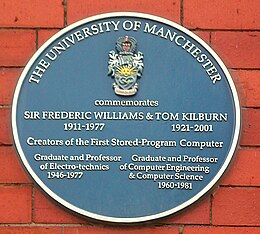Tom Kilburn
Tom Kilburn CBE FRS | |
|---|---|
 Tom Kilburn | |
| Born | 11 August 1921 Dewsbury, Yorkshire, England |
| Died | 17 January 2001 (aged 79) Manchester, England |
| Nationality | English |
| Education | Wheelwright Grammar School for Boys |
| Alma mater |
|
| Known for | |
| Spouse |
Irene Marsden (m. 1943) |
| Children | 2[1] |
| Awards |
|
| Scientific career | |
| Institutions | |
Frederic Calland Williams | |
Tom Kilburn
A graduate of
Early life and education
Tom Kilburn was born in Earlseaton near Dewsbury, Yorkshire, on 11 August 1921,[7] the only son of John William Kilburn, a wool mill clerk who later became a company secretary, and his wife, Ivy Mortimer. From 1932 to 1940,[8] he attended the Wheelwright Grammar School for Boys, where the headmaster encouraged his aptitude for mathematics.[9] He also played sports, notably running.[8]
In 1940, Kilburn entered
Career and research
On graduation, Kilburn was recruited by
Kilburn's wartime work inspired his enthusiasm for some form of electronic computer. The principal technical barrier to such a development at that time was the lack of any practical means of
In December 1946, Williams took up the Edward Stocks Massey Chair of
Manchester computers
Kilburn anticipated a return to Malvern but Williams persuaded him to stay to work on the university's collaborative project developing the
Over the next three decades, Kilburn led the development of a succession of innovative
While Kilburn led one design team working on Meg, he led another with Dick Grimsdale and Douglas Webb, on a research project examining what he believed would be the next step forward in computer design: the use of transistors. The 48-bit machine they completed in November 1953 was the world's first transistor computer, with 550 diodes and 92 transistors, and was manufactured by STC. An improved version completed in April 1955 had 1,300 diodes and 200 transistors, and was sold by Metropolitan-Vickers as the Metrovick 950.[9]
Kilburn's next project, known as

Kilburn became a professor of computing engineering in the Department of Electrical Engineering at Manchester in 1960. He was instrumental in forming the
Awards and honours
Over the years, Kilburn received numerous awards and accolades. He was elected a

Kilburn received the IEEE Computer Society
Professor of Computer Engineering in the University of Manchester. He was a pioneer in the engineering realisation of the general purpose electronic digital computer and has made major contributions to the rapid rate of development that has occurred in this field over the past 15 years. His contributions cover the whole range from overall system design to the invention of high speed circuits to meet particular needs. His latest machine, 'Atlas' may well be the most advanced machine currently under construction anywhere in the World.[30]
Personal life
Kilburn married Irene Marsden in 1943 and had two children, one daughter and one son.
After his wife's death, Kilburn lived alone in the modest house they had shared in Manchester. He did not own a personal computer.
References
- ^ doi:10.1093/ww/9780199540884.013.U23039. (Subscription or UK public library membershiprequired.)
- ^ Tom Kilburn publications indexed by Google Scholar
- S2CID 31699280.
- .
- S2CID 6971607.
- OCLC 156380308.
- S2CID 71234844.
- ^ doi:10.1093/ref:odnb/55314. (Subscription or UK public library membershiprequired.)
- ^ S2CID 42682473.
- ISSN 1058-6180.
- ISSN 0958-7403. Retrieved 15 March 2012.
- ^ a b c d e Anon (2001). "Professor Tom Kilburn". telegraph.co.uk. London: The Daily Telegraph. Retrieved 16 August 2014.
- .
- EThOS uk.bl.ethos.488439. A first version of this thesis was written by Kilburn with the same title, as a personal report to the Telecommunications Research Establishment (TRE) to obtain a second year of secondment to the University of Manchester. Kilburn has stated that whilst he was writing it, requests for copies came in. Twenty copies were therefore made, and the document was circulated as an Internal Report by the Department of Electrotechnics, University of Manchester, dated 1st December 1947. Due to demand, a further 30 copies were made. It is known that several copies were taken to the USA by Douglas Hartree, Harry Huskeyand A. M. Utley (TRE) in the Spring of 1948
- ^ .
- PMID 15392930.
- S2CID 4110351. Archived from the originalon 6 April 2009.
- S2CID 5694189.
- S2CID 4216071.
- ^ a b Hilary J Kahn. "Obituary: Tom Kilburn". The Guardian. Retrieved 16 August 2014.
- .
- .
- .
- ^ "Roll of Distinguished Fellows". BCS – The Chartered Institute for IT. Retrieved 22 February 2016.
- ^ Computer History Museum. "Tom Kilburn – CHM Fellow Award Winner". Archived from the original on 3 April 2015. Retrieved 30 March 2015.
- ^ "No. 45984". The London Gazette (Supplement). 22 May 1973. p. 6480. Commander of the Most Excellent Order of the British Empire
- ^ "Honorary Graduates 1966 to 1988". University of Bath. Retrieved 22 February 2016.
- ^ "W. Wallace McDowell Award". IEEE Computer Society. Retrieved 22 February 2016.
- ^ "BCS IT Awards: 1973 – 1999". BCS – The Chartered Institute for IT. Retrieved 22 February 2016.
- ^ a b "Tom Kilburn EC/1965/18: Library and Archive Catalogue". London: The Royal Society. Archived from the original on 29 April 2014.
- ^ "Computer Pioneer Award". IEEE Computer Society. Retrieved 22 February 2016.
- ^ "Eckert Mauchly Award". IEEE Computer Society. Retrieved 22 February 2016.
- ^ "Mountbatten Medal – Medal Recipients". Institute of Engineering and Technology. Retrieved 22 February 2016.
- ^ "50 years of Computer Science at Manchester". The University of Manchester – Department of Computer Science. Retrieved 22 February 2016.
- ^ "The Kilburn Building". manchesterhistory.net. Retrieved 2 September 2023.
Additional source
1981: Tom Kilburn - Yorkshire's Computing Pioneer.
